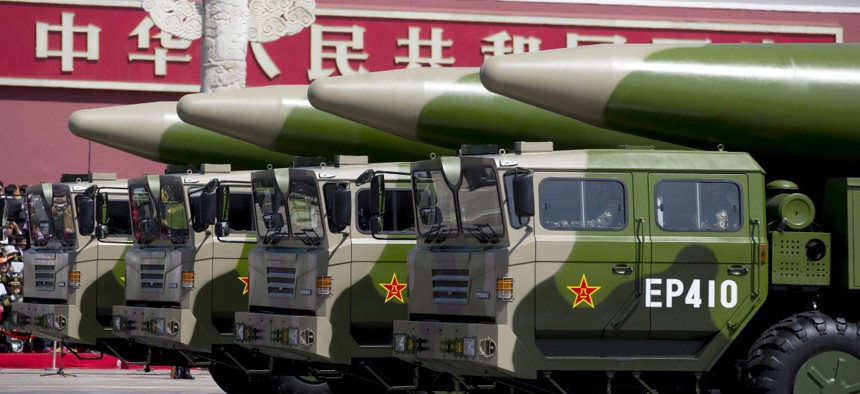
China’s DF-26 intermediate-range ballistic missile (IRBM). AP / Andy Wong, Pool
It’s Too Late for US-Russia-China Arms-Control Fantasies
As U.S. and Russian negotiators open two days of talks in Vienna, they should waste no more time talking about a tripartite agreement.
For the first time in over five months, U.S. and Russian officials are meeting this week in Vienna to discuss a possible new nuclear weapons reduction agreement. The State Department extended a formal invitation to Beijing upon announcing the talks on June 19. The only issue: Chinese officials quickly rejected the invite and are in no mood to discuss, let alone curtail, their nuclear weapons stockpile.
Washington therefore has a choice. It could stick with its current position by holding the New Strategic Arms Reduction Treaty, or New START, hostage to China’s participation. Or it can reorient its strategy, do away with grandiose ambitions and extend New START for another five years. The former is a road to a 21st-century nuclear arms race; the latter a responsible shift to preserving the last strategic arms agreement between the world’s two largest nuclear powers.
Related: New START Treaty Looks Dead in the Water
Related: A New Nuclear Deal? Start with New START
Related: If New START Dies, These Questions Will Need Answers
The Trump administration’s intent to enlist China into an overarching strategic arms accord is sensible. Lt. Gen. Robert Ashley, the Director of the Defense Intelligence Agency, said last year that Beijing "is likely to at least double the size of its nuclear stockpile.” Washington has stood by this assessment and cited the lackluster transparency of China’s nuclear development as a reason why Beijing cannot be permitted to continue building its arsenal unencumbered.
The Chinese Communist Party has taken full advantage of its presence outside of Cold War-era arms control treaties to assemble strategic weapons Washington and Moscow have been prohibited from developing over the last three decades. China has assembled 2,200 mid- and long-range land-based missiles—the very missile class the U.S. and Russia were banned from deploying, producing, or possessing due to the now-defunct Intermediate Range Nuclear Forces Treaty. Beijing is also in the process of completing their very own nuclear-triad.
Unfortunately, just because China is a logical candidate for a trilateral arms control accord does not mean such an accord will happen. Ever since the Trump administration brought up the prospect, Chinese officials have strongly resisted it. China’s position is highly unlikely to change regardless of how many times Washington makes the demand.
For one, China has no incentive to participate. The U.S. and Russia possess a combined 12,170 nuclear warheads, 90 percent of the world’s total stockpile. Beijing’s own arsenal of 320 warheads is roughly one-twentieth the size of either Moscow’s or Washington’s. It makes no sense for Chinese President Xi Jinping to authorize a cap or rollback of his country's nuclear weapons program when Beijing’s two principal competitors have such a quantitative advantage. If the roles were reversed and the U.S. was in China’s position, Washington would very likely make the same decision.
Moscow is unlikely to be of much assistance. While U.S. officials expect Russia to help convince China to enter a dialogue, the Russians have been clear that this is not their responsibility. In the words of Anatoly Antonov, Russia’s abassador to the United States, "China should itself decide whether these talks are beneficial for the country…We will not push [them] towards the decision needed for Americans.” If Washington is banking its arms-control strategy on Moscow riding to the rescue on behalf of U.S. objectives, it will be disappointed.
Then there is the issue of the clock. Even if Chinese officials did dramatically change their stance and agree to nuclear talks with Washington and Moscow, there would not be enough time to negotiate a highly complicated strategic arms agreement with dozens of pages of technical annexes, monitoring mechanisms, and dispute resolution channels — all of which U.S., Russian, and Chinese negotiators would need to agree to — before the New START agreement expires on February 5, 2021. New START took 12 months to negotiate and finalize. The Open Skies Treaty was concluded only after two years of negotiations. The INF Treaty, perhaps the signature arms control agreement of the Cold War, was signed in 1987 only after a six-year series of starts, stops, and breakdowns.
Washington must dispense with the fantasy that a trilateral nuclear pact is possible in the foreseeable future. It is simply too much to ask U.S., Russian, and Chinese negotiators to achieve such a feat in the next eight months.
The pragmatic solution for the U.S. is to extend New START unconditionally for another five years. With a quick stroke of a pen, the U.S. and Russia will not only maintain a regime of transparency, predictability, and understanding over one another’s nuclear arsenals—they will also add additional time to the clock to explore their options vis-a-vis China.
New START has been enormously successful at preserving strategic stability between two nuclear superpowers. To allow this agreement to die without another arrangement in place is bad strategy and even worse policy.



